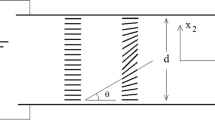Abstract
Low molar mass liquid crystal solvents with positive dielectric anisotropy exhibit an electro-rheological (ER) effect such that the viscosity, ηon, in the presence of a strong electric field, applied transverse to the flow, is larger than that, ηoff, in the absence of such a field. Dissolution of a liquid crystal polymer (LCP) enhances the magnitude of the ER effect (ηon - ηoff) by an amount, σηon - σηoff which is an increasing function of LCP concentration and depends on the molecular architecture of the LCP Specifically, we show that two main-chain LCPs, with different chemical structures, strongly increase the ER response, a side-on side-chain LCP moderately increases the response, and an end-on side-chain LCP weakly increases the response. These diverse behaviors can be interpreted using theoretical arguments which assume that the LCP conformation is an ellipsoid of revolution whose orientation relative to the flow direction is determined by the balance between the hydrodynamic and electric torques on the fluid. The different ER responses are consistent with the idea that main-chain LCPs are highly prolate, the side-on side chain LCP is moderately prolate, and the end-on side chain LCP is quasi-spherical. A molecular description is obtained by equating ηon, and ηoff, respectively, to the Miesowicz viscosities ηc and ηb, and using a hydrodynamical model developed by Brochard which deduces that σηc/σηb = R 4‖ /R 4⊥ , where R ‖ and R ⊥ are the end-to-end distances of the chain, respectively, parallel and perpendicular to the director.
Similar content being viewed by others
References
Appelt B, Meyerhoff G (1979) A low shear viscometer with automated recording and application to high molecular weight polystyrene solution. Macromolecules 12:968
Brochard F (1979) Viscosities of dilute polymer solutions in nematic liquids. J Polymer Sci, Polym Phys Ed 17:1367
Carlsson T, Skarp K (1981) The stabilizing effect of an electric field on the shear flow of nematic liquid crystal when α3 > 0: flow alignment regained. Mol Cryst Liq Cryst 78:157
Chen F-L, Jamieson AM (1993) Odd-even effect in the viscoelastic properties of main-chain liquid crystal polymer-low molar mass nematogen mixtures. Macromolecules 26:6576
Chen F-L, Jamieson AM (1994) Temperature and molecular weight dependence of the viscometric properties of main-chain liquid crystal polymers in nematic solvents. Macromolecules 27:4691
Chen F-L, Jamieson AM (1994) Molecular weight-dependence behavior of the twist distortion in a nematic monodomain containing a main-chain liquid crystal polymer. Macromolecules 27:1943
Chen F-L, Jamieson AM, Kawasumi M, Percec V (1995) Viscoelastic properties of dilute nematic mixtures containing cyclic and hyperbranched liquid crystal polymers dissolved in a nematic solvent. J Polym Sci Polym Phys 33:1213
Chiang Y-C, Jamieson AM, Kawasumi M, Percec V (1997) Electrorheological behavior of main-chain liquid crystal polymers dissolved in nematic solvents. Macromolecules 30:1992
Chien LC et al. (1997) in preparation
Gu D-F, Jamieson AM, Kawasumi M, Lee M, Percec V (1992) Dynamic light scattering from nematic monodomains containing mesogenic polymers of differing architecture. Macromolecules 25:2151
Gu D-F, Jamieson AM (1994) Rheological characterization of director dynamics in a nematic monodomain containing mesogenic polymers of differing architectures. Macromolecules 27:337
Gu D-F, Jamieson AM (1994) Shear deformation of hoineotropic monodomains: temperature dependence of stress response for flow-aligning and tumbling nematics. J Rheology 38:555
Han HW, Rey AD (1995) Simulation and validation of temperature effects on the nematorheology of aligning and nonaligning liquid crystals. J Rheol 39:301
Hardouin F, Leroux N, Mery S, Noirez L (1992) Small-angle neutron-scattering experiments on side-on fixed liquid-crystal polysiloxanes. J de Phys II 2:271
Jeffrey GB (1922) The motion of ellipsoidal particles immersed in a viscous fluid. Proc Roy Soc (London) A102:161
Kawasumi M, Percec V (1991) Liquid-crystalline polyethers based on conformational isomerism. 18. Polyethers based on a combined mesogenic unit containing rigid and flexible group. 1-(4-hydroxy-4′-biphenyl)-2-(4-hydroxyphenyl) butane. Macromolecules 24:6318
Portugal M, Ringsdorf H, Zentel R (1982) Synthesis and phase behaviour of liquid crystalline polyacrylates. Makromol Chem I 183:2311
Skarp K, Carlsson T, Lagerwall ST, Stebler B (1981) Flow properties of nematic 8CB: an example of diverging and vanishing α3. Mol Cryst Liq Cryst 66:199
Yang I-K, Shine AD (1992) Electrorheology of a nematic poly(n-hexyl isocyanate) solution. J Rheol 36:1079
Yang I-K, Shine AD (1993) Transient shear flow of a unidomain liquid crystalline polymer. Macromolecules 26:1529
Author information
Authors and Affiliations
Rights and permissions
About this article
Cite this article
Chiang, YC., Jamieson, A.M., Campbell, S. et al. Effect of molecular architecture on the electrorheological behavior of liquid crystal polymers in nematic solvents. Rheol Acta 36, 505–512 (1997). https://doi.org/10.1007/BF00368128
Received:
Accepted:
Issue Date:
DOI: https://doi.org/10.1007/BF00368128



